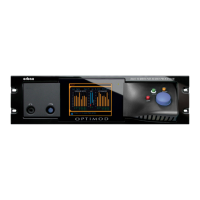OPTIMOD SURROUND PROCESSOR INTRODUCTION
1-21
BYPASS is not appropriate for normal on-air use because switching to and from it
will usually cause clicks or other program disruptions and because it does not protect
against inadvertent output clipping. To defeat the dynamics processing on-air
(which might be desired when switching from a local to a network program, for ex-
ample), use the P
ASS-THROUGH factory preset or a user preset derived from the PASS-
T
HROUGH factory preset.
Calibrated Line-up Tones
To facilitate matching the output level of the 8685 to the transmission system that it
is driving, the 8685 contains a test tone oscillator that produces sine waves at 8685’s
outputs. You can adjust the frequency and modulation level of the built-in line-up
tone via the front panel or PC Remote software, and you can specify which outputs
emit the tone. Outputs that do not emit the tone are automatically set to B
YPASS,
which facilitates using the tone oscillator as a sinewave source to test the 8685—use
a cable to connect an output that is emitting the tone to an input that is in B
YPASS
mode. (See step 4 on page 4-11 for an example.) You can use the front panel, the
PC
Remote software, or the opto-isolated remote control interface ports to activate
the Test Tone.
Setting Output/Modulation Levels
In a perfect world, one could set the peak level at OPTIMOD 8685’s output to 0 dBfs.
However, there are several potential problems that may make it desirable to set the
modulation level slightly lower.
• First is asynchronous re-sampling, which we have discussed earlier in this chapter.
(See page 1-14.) If any digital processing that causes its output samples to be
asynchronous to its input samples is used after
OPTIMOD 8685’s output, this can
cause the peak levels of individual samples to increase above the nominal
threshold of limiting. This increase is typically less than 0.5dB.
• Second is additional processing, like equalization. Equalization that applies
boosts at certain frequencies is very likely to add peak level and thus cause clip-
ping. However, equalization that attenuates certain frequencies can also cause
overshoots because of added phase shifts. So be wary of any equalization and al-
low headroom to accommodate it.
• Third is headroom in lossy data compression systems. A well-designed perceptual
encoder will accept samples up to 0dBfs and will have enough internal head-
room to avoid clipping. However, there is no guarantee that receiver manufac-
turers or decoder providers will implement perceptual decoders with sufficient
headroom to avoid clipping overshoots. Such overshoots are the inevitable side
effect of increasing the quantization noise in the channel, and can be as large as
3-4dB. Most perceptual encoder algorithms are designed to have unity gain from
input to output. So if peak levels at the input frequently come up to 0dBfs, peak
levels at the output will frequently exceed 0dBfs (and will be clipped) unless the
decoder algorithm is adjusted to have less than unity gain.

